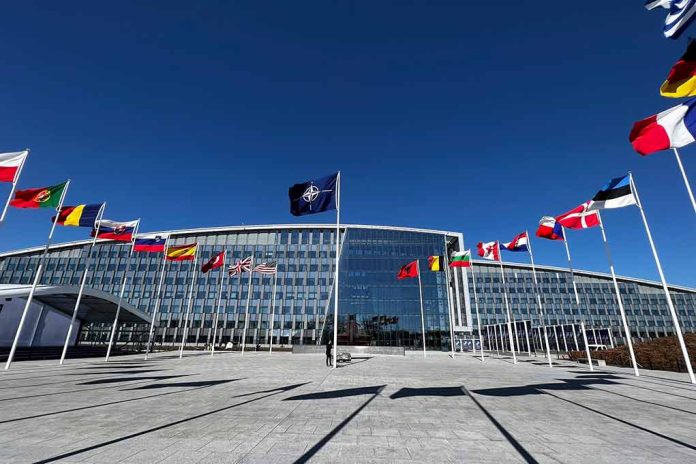
As Russia builds up forces along its border with Finland, NATO’s Northern Strike 125 exercises involving 6,000 troops send a clear message that the alliance stands ready to defend its newest member states.
Key Takeaways
- NATO is conducting Northern Strike 125 in Finland with over 6,000 troops from Finland, Sweden, and Britain, showcasing artillery and drone capabilities near the Russian border.
- Satellite images reveal Russia significantly expanding military infrastructure along its 800-mile border with Finland, including new troop accommodations and aircraft shelters.
- Finland has abandoned its long-standing neutrality to join NATO and is increasing defense spending to 3% of GDP by 2029, while building a border fence expected to take four years to complete.
- Military analysts warn Russia could be preparing for potential operations against NATO’s northern flank, with the capability to mobilize up to 600,000 troops by 2030.
- Finland maintains a robust defense posture with plans to mobilize up to one million reservists by 2031, demonstrating its commitment to NATO’s collective security.
NATO Flexes Military Muscle in Finland’s Arctic Training Grounds
NATO’s Northern Strike 125 exercise is underway in northern Finland, marking a significant show of force as tensions with Russia continue to escalate. More than 6,000 soldiers from Finland, Sweden, and Britain are participating in the joint live-fire exercises near Finland’s border with Russia. The drills represent the first major NATO operation in Finland since it joined the alliance in April 2023, abandoning decades of military non-alignment following Russia’s invasion of Ukraine. These exercises are specifically designed to enhance NATO’s artillery and drone capabilities in the challenging Arctic environment.
“This is a really obvious demonstration of how NATO capability can come to Finland. You can’t ignore the fact that there’s a land war in Ukraine at the moment, and part of the role of NATO is in deterrence. In order to deter, you’ve got to be visible,” said Brigadier Nick English of the British Army.
The exercises are taking place in Finland’s extensive northern training grounds, which provide ample space for testing advanced military systems including Swedish Archer self-propelled howitzers and various drone technologies. Finland shares an 800-mile border with Russia, and the geographical proximity adds strategic significance to these military drills. The Finnish military, with its robust capacity of 280,000 personnel and the ability to mobilize up to one million reservists by 2031, represents a significant addition to NATO’s eastern defensive capabilities.
Russia’s Military Buildup Raises Alarm Bells
Satellite imagery has revealed an alarming expansion of Russian military infrastructure near the Finnish border. New troop accommodations, warehouses, and renovated aircraft shelters have been identified at multiple locations, indicating a systematic strengthening of Russia’s northern military presence. The Kremlin has been vocal about its opposition to NATO’s expansion, with spokesman Dmitri Peskov declaring, “The enlargement of NATO is an encroachment on our security and on Russia’s national interests.”
Russia is reportedly planning to establish a new army headquarters in Petrozavodsk, just 180 miles from the Finnish border. Military analysts suggest that Russia could be preparing for potential operations against NATO’s northern flank, with some reports indicating the capability to mobilize up to 600,000 troops. A Finnish government report warned that “Russia is strengthening its military presence and activities in its northwestern direction in all operational environments as quickly as possible.”
“Before 2022 there was an unmanned aerial vehicle regiment somewhat operating in the field – so it wasn’t totally abandoned. But it wasn’t being used for larger equipment such as helicopters,” explained Emil Kastehelmi, a Finnish open-source intelligence analyst, highlighting the significant expansion of Russian military facilities. Defense experts point out that the remilitarization of NATO’s eastern flank has complicated Russia’s strategic position, forcing it to disperse its forces across a wider area than before Finland and Sweden joined the alliance.
Finland Bolsters Border Security and Defense Capabilities
In response to the perceived Russian threat, Finland has initiated the construction of a border fence, a project expected to take four years to complete. The Finnish government has also committed to increasing defense spending to at least 3% of GDP by 2029, well above NATO’s 2% target. Additionally, Finland is raising its reservist age limit to 65, further expanding its already substantial military capabilities. These measures reflect Finland’s longstanding approach to national defense, which has always maintained a high level of preparedness even during its neutral era.
The strategic significance of Finland’s border region cannot be overstated. The proximity to St. Petersburg, Russia’s second-largest city and a vital economic hub, means that any military activity in this area has heightened implications for Russian security planning. Defense analysts warn that Russia’s experience in Ukraine has led to concerning adaptations in military doctrine, with the Finnish government report specifically cautioning about potential attacks on civilian populations based on Russia’s tactics in Ukraine. This new security reality has transformed the once peaceful Nordic-Baltic region into one of Europe’s most militarized zones.
“Nobody in their right mind wants to think that a European war is around the corner again. But the reality is an increasing number of European intelligence officials have been telling us that,” warned Ian Bond, director of foreign policy at the Centre for European Reform.









